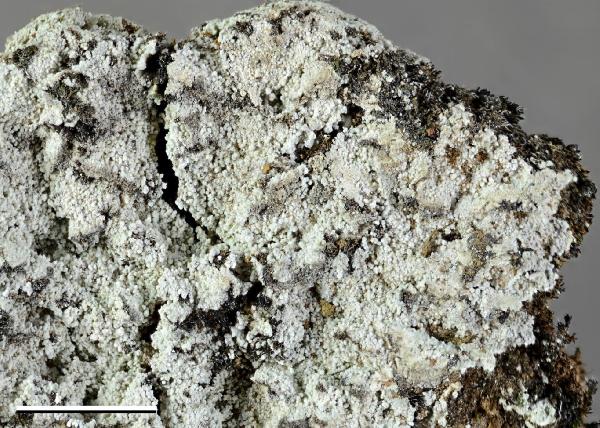Lepraria borealis Loht. & Tønsberg
Ann. Bot. Fenn., 31: 224, 1994.
Synonyms:
Distribution: N - Frl (Baruffo & al. 2006), TAA (Ravera & al. 2019b), Piem (Baruffo & al. 2006, Gheza & Nascimbene 2024), VA (Baruffo & al. 2006), Emil (Baruffo & al. 2006, Fariselli & al. 2020). C - Tosc (Baruffo & al. 2006, Benesperi & al. 2007), Sar (Baruffo & al. 2006).
Description: Thallus crustose to subleprose, whitish to whitish grey, up to 0.7 mm thick, entirely consisting in a mass of granules, usually well-delimited, sometimes indistinctly sublobate at margin. The thallus starts developing as isolated, dispersed granules that form piles, or aggregations (best visible along the margins, where the dispersion of the young granules is most readily observed), which eventually overlap and become confluent, giving the false appearance of a continuous thallus in older areas. Granules rather firmly attached, coarse, 60-260(-320) μm in diam., with a compact, pseudocorticate surface, rarely with a few, short projecting hyphae. Medulla absent or very thin. Photobiont chlorococcoid. Spot tests K+ yellow, C-, KC-, P+ yellowish, UV-or UV+ dull pink. Chemistry: atranorin, rangiformic acid (major), norrangiformic acid (traces). Note: a circumboreal species growing on siliceous rocks and over epilithic mosses, mostly on horizontal or weakly inclined surfaces wetted by rain, with optimum in the oroboreal to Alpine belts of the Alps, but also occurring in the high Mediterranean mountains.
Growth form: Leprose
Substrata: rocks, soil, terricolous mosses, and plant debris
Photobiont: green algae other than Trentepohlia
Reproductive strategy: mainly asexual, by soredia, or soredia-like structures (e.g. blastidia)
Commonnes-rarity: (info)
Alpine belt: rather rare
Subalpine belt: rather rare
Oromediterranean belt: extremely rare
Montane belt: very rare
Submediterranean belt: extremely rare
Padanian area: absent
Humid submediterranean belt: absent
Humid mediterranean belt: absent
Dry mediterranean belt: absent

Predictive model
Herbarium samples

Source: Lindblom, L., Blom, H. H. & Arup, U. 2023. Additions to the lichen flora of the Gaupne area – a species hot- spot in Norway. Graphis Scripta 35 (6): 75–80. Oslo. ISSN 2002-4495. - CC BY-4.0
Herbarium photograph of the specimen from Gaupne (Lindblom 1360, O L-
229230, GenBank OP554448). Scale bar = 5 mm. Photo E. Timdal.
Growth form: Leprose
Substrata: rocks, soil, terricolous mosses, and plant debris
Photobiont: green algae other than Trentepohlia
Reproductive strategy: mainly asexual, by soredia, or soredia-like structures (e.g. blastidia)
Commonnes-rarity: (info)
Alpine belt: rather rare
Subalpine belt: rather rare
Oromediterranean belt: extremely rare
Montane belt: very rare
Submediterranean belt: extremely rare
Padanian area: absent
Humid submediterranean belt: absent
Humid mediterranean belt: absent
Dry mediterranean belt: absent

Predictive model
| Herbarium samples |

 INDEX FUNGORUM
INDEX FUNGORUM
 GBIF
GBIF
 DOLICHENS
DOLICHENS



